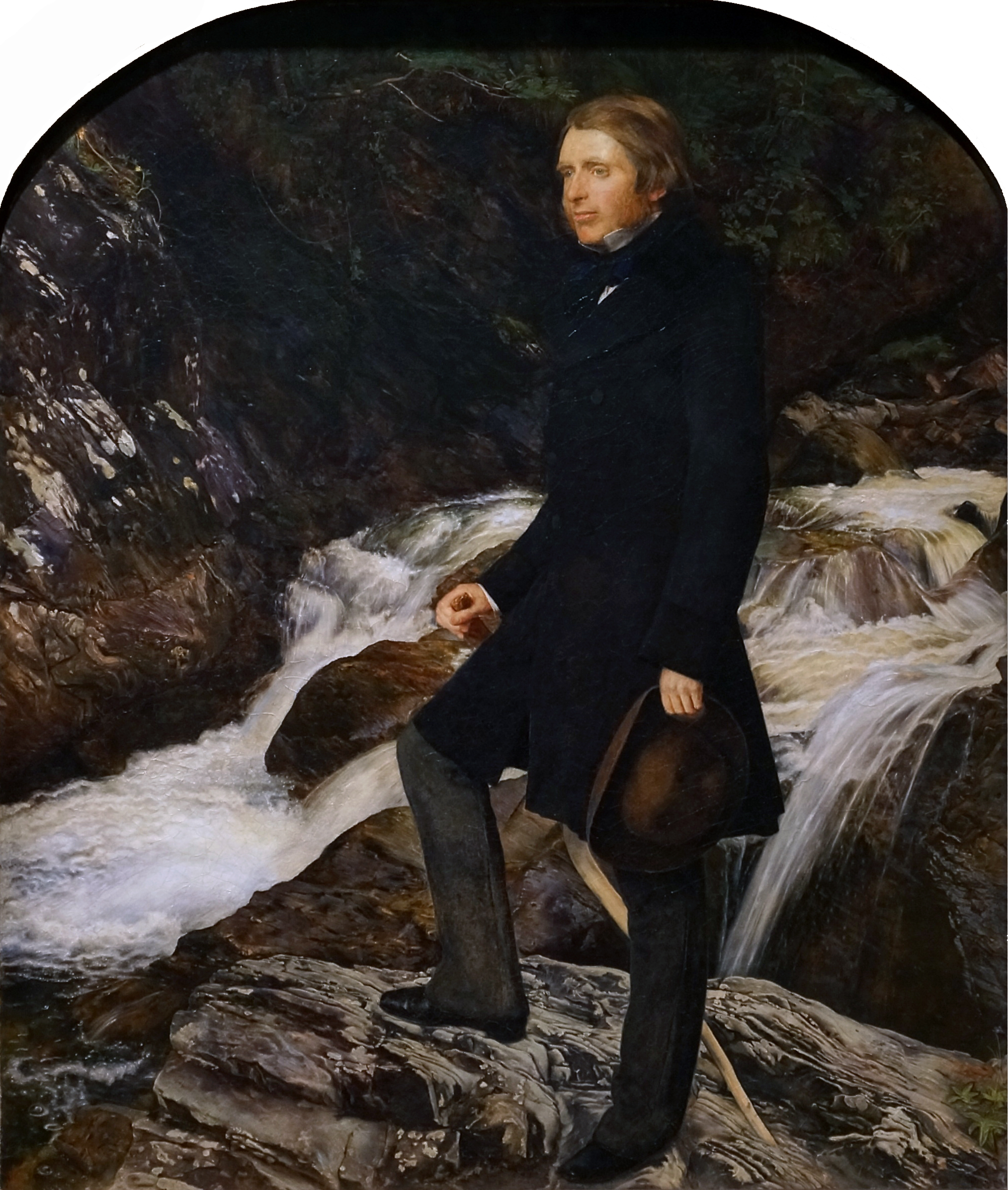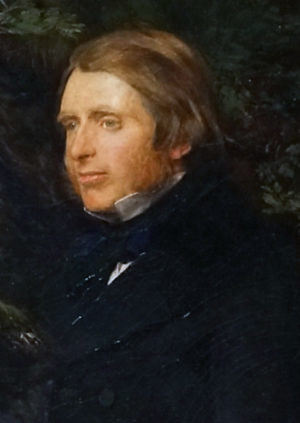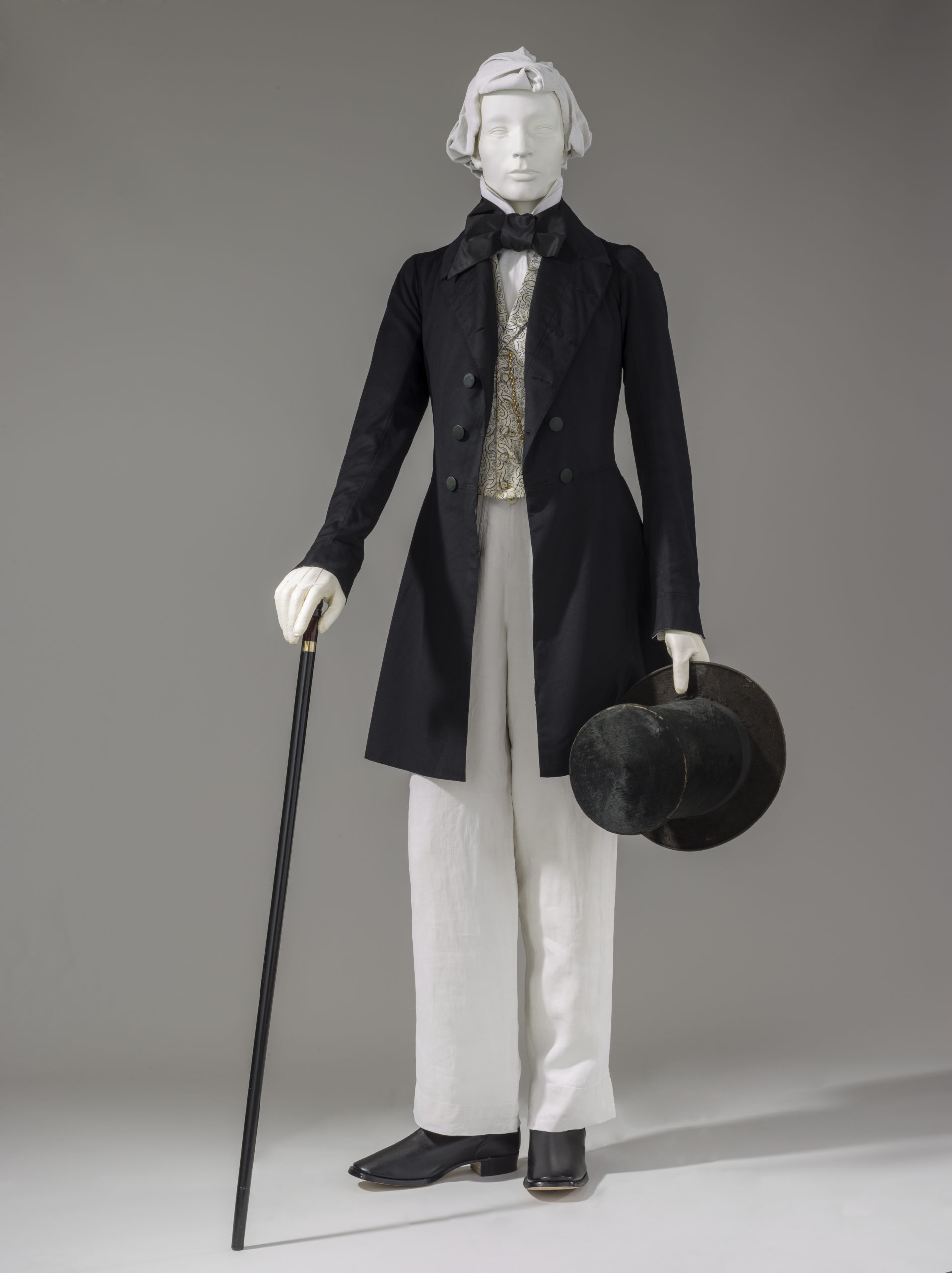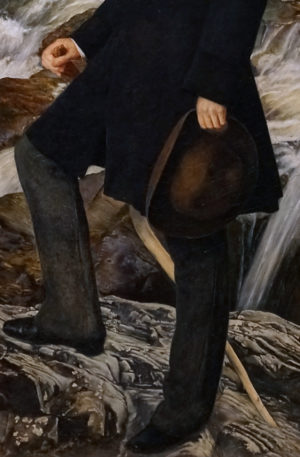
John Everett Millais, John Ruskin, c. 1853-54, oil on canvas, 78.7 x 68 cm (Ashmolean Museum, Oxford)
While the skill of a portrait artist is often judged by whether or not the work resembles the sitter, a portrait may also reveal something about the sitter as well as fashionable norms of the time. What does John Ruskin reveal about himself in his choice of attire for his commissioned portrait by John Everett Millais? In this life-size oil painting, Millais depicts the art critic and polymath standing on a narrow rocky ledge looking downstream as the river rushes behind him. He is dressed in formal daywear suitable for a gentleman — a dark-colored wool double-breasted frock coat that comes to his knees worn over a crisp white shirt, and gray trousers.
Masculine dress in the nineteenth century

John Everett Millais, John Ruskin, detail, c. 1853-54, oil on canvas, 78.7 x 68 cm (Ashmolean Museum, Oxford)
During the nineteenth century, the dress of men differed markedly from that of the previous century. They cast aside the flamboyant, colorful and decorative looks worn by men like Charles II in the eighteenth century. Instead, the elegant gentleman of the Victorian era was often seen wearing relatively dark and sober attire. In dressing this way, men seemed to have rejected fashion, a phenomenon historians often refer to as “The Great Male Renunciation of Fashion.” The contrast between the seemingly dark and sober menswear and the ornate and decorative dress worn by women aligned with traditional gender roles that cast women as ornamental accessories of their fathers or husbands in the nineteenth century.
Nonetheless, a closer look at menswear of the nineteenth century shows that fashion was indeed present and can be found in small and subtle details, such as the quality of the cloth, the length of the coat, the style of the necktie, the height of the collar, and the fit of the trousers. In fact, it was just these types of details that conveyed a man’s status, wealth and identity.
Reading the clues of dress
Ruskin is wearing an ensemble that was considered formal urban daywear. This type of dark and sober costume was the uniform of respectability, worn by members of Parliament, bankers, judges, doctors and gentleman. He wears this elegant attire even though he is deep in the wilderness in a hard-to-reach ravine in Scotland, communicating the idea that he is an educated gentleman.
Ruskin’s crisp white collared shirt emerges at the neckline and cuffs to show that he has the financial means to have his clothing laundered. The black or dark blue stock or necktie, wrapped smoothly around his neck, also denotes his social class. The dark long-waisted wool frock coat that comes to his knees creates a smooth line over his slender body and exemplifies the work of a skilled tailor.
It is interesting that Ruskin did not select a looser-fitting hunting jacket for his portrait but instead chose clothing that he might have worn to give a lecture on architecture and painting. Millais’ initial sketches for this portrait made on site in Glen Finglas (Scotland) show Ruskin wearing this or a similar formal daywear ensemble even though the painting was later finished in the artist’s studio in London.

Man’s Frock Coat and Trousers, circa 1852 (Los Angeles County Museum of Art)
A comparable ensemble dated to 1852 from the collection of the Los Angeles County Museum of Art reveals the waistcoat or vest typically worn under the frock coat. The key difference is that this ensemble is accessorized with two items found in every gentleman’s wardrobe from that time — a silk top hat and a walking stick.

John Everett Millais, John Ruskin, detail, c. 1853-54, oil on canvas, 78.7 x 68 cm (© Ashmolean Museum, Oxford)
Ruskin’s walking stick
Ruskin chose more casual versions of these accessories for his portrait by Millais. In the painting, he holds a brown felt hat in his left hand and a walking stick fashioned from a tree branch in the other. He is a gentleman, but with these choices he reveals his affinity for and love of nature, a topic that he also lectured on. He once wrote: “I would rather teach drawing that my pupils learn to love nature, than teach the looking at nature that they may love to draw.”
In subsequent decades, Ruskin would be described as a slightly stooped figure who was somewhat old-fashioned in his dress. In 1884, the young Beatrix Potter recorded seeing Ruskin at the Royal Academy in her diary noting that he was “one of the most ridiculous figures” she had ever seen, and she observed that he wore “a very old hat, much necktie and aged coat buttoned up to his neck.” Nonetheless, in 1853-1854 when Millais painted his portrait, Ruskin emulated the ideal attire worn by an elegant gentleman, albeit with his own unique touch.
Details of men’s attire are often less visible than women’s dress, especially since men’s suits are one of the most ubiquitous and enduring symbols of masculinity. Nonetheless, small details, such as the choice of accessories or the cut and quality of a suit, may reveal important clues to a sitter’s identity.
Additional resources:
This painting at the Ashmolean Museum, Oxford
Read more about this portrait of John Ruskin
Christopher Breward, The Suit: Form, Function & Style (London: Reaktion Books, 2016)
James S. Dearden, John Ruskin: A Life in Pictures (Sheffield: Sheffield Academic Press, 1999)
Ingrid E. Mida, Reading Fashion in Art (London: Bloomsbury Visual Arts, 2020)




